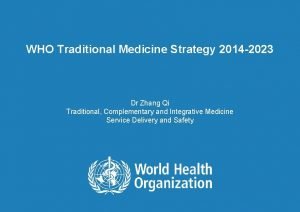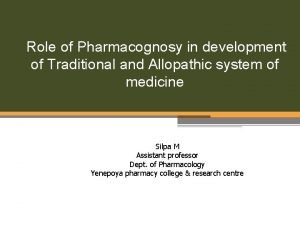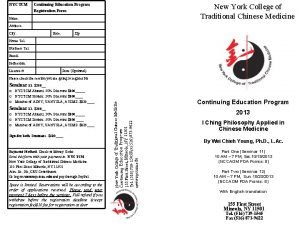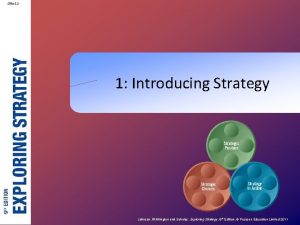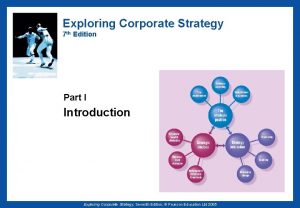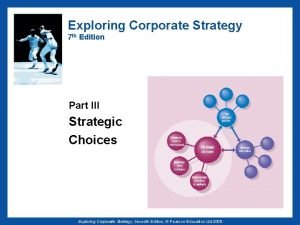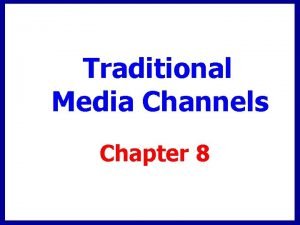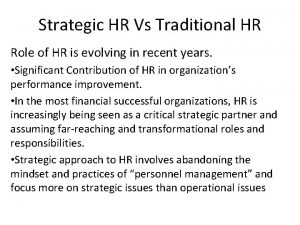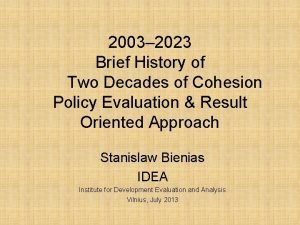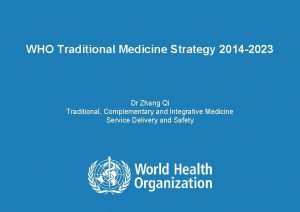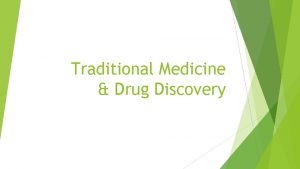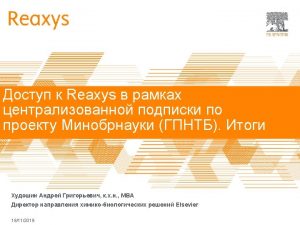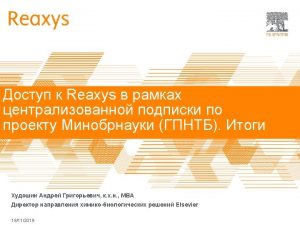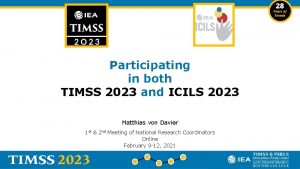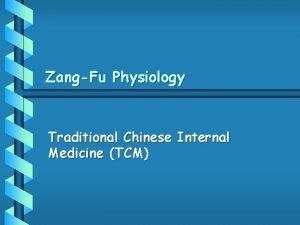WHO Traditional Medicine Strategy 2014 2023 Exploring its



























- Slides: 27

WHO Traditional Medicine Strategy 2014 -2023 Exploring its relevance to FICTA strategic planning Prepared & Presented by Pauline Jones, KAI at FICTA 2015 AGM

Purpose The purpose of this presentation is to provide a focus for to-days discussion on developing a framework for FICTA's future strategic activities 01/02/2015

Background -1 The WHO Traditional Medicine (TM) Strategy 2014– 2023 was developed in response to the World Health Assembly resolution on traditional medicine In the view of the World Health Organisation “TM has a long history of use in health maintenance and in disease prevention and treatment, particularly for chronic disease. ”

Background – 2 • This WHO 10 year strategy document is the latest in a series of documents, studies and proposals that WHO has produced since 2000. As well as 2 previous strategy documents, this current one refers to 54 documents in total. • It is strongly supportive the availability of Traditional and Complementary Medicine (T&CM) and its integration with conventional medicine.

Section 4 (Page 43) Section 4 of the strategy lists WHO's objectives and also provides a framework of strategic actions for developing and managing the availability of T & CM to be undertaken by: – Member States – Partners and Stakeholder – WHO itself

WHO Strategy 2014 -2023 The goals for the WHO Traditional Medicine Strategy 2014 -2023 is to support Member States in: 1. harnessing the potential contribution of T&CM to health, wellness and people-centred health care; 2. promoting safe and effective use of T&CM through the regulation, evaluation and integration of T&CM products, practices and practitioners into health systems, as appropriate.

Relevance to FICTA • Governments will refer to this document • FICTA can rightly claim to be a Stakeholder and Partner • By expressing FICTA policy in the terminology of the WHO recommendations for strategic actions for Stakeholders and Partners, FICTA can claim a powerful ally in its representations to government, using their own language

Implementing the Strategy The goals for the FICTA Strategy 2014 -2023 could also be to support the Irish Government in: 1. harnessing the potential contribution of T&CM to health, wellness and people-centred health care; 2. promoting safe and effective use of T&CM through the regulation, evaluation and integration of T&CM products, practices and practitioners into the Irish health systems, as appropriate.

Prime Objective 1 To build the knowledge base for active management of T&CM through appropriate national policies (page 45). sub-prime objectives: Understand recognize the role and potential of T&CM (4. 1. 1) Strengthen the knowledge base, build evidence and sustain resources (4. 1. 2. )

(Objective – 4. 1. 1) Strategic actions for partners and stakeholders : 1. Establish best practices in cooperation with accredited bodies of practitioners and researchers which can be shared internationally. 2. Make recommendations concerning research priorities in specific areas for policy formulation.

Objectives – 4. 1. 2 - a Strategic actions for partners and stakeholders: 1. Support collaboration with Member States and WHO in research projects/programmes on T&CM. 2. Advise on assessing risks and benefits. 3. Foster a culture of communication, documentation, evaluation and innovation among practitioner communities, both nationally and internationally.

Objectives – 4. 1. 2 - b Strategic actions for partners and stakeholders: 1. Increase the availability and awareness of the literature, database and other knowledge repositories. 2. Develop research methodologies consistent with T&CM theories and practice.

Objectives – 4. 1. 2 - c Strategic actions for partners and stakeholders: 1. Build up the capacity and capability for international research, including such issues as the adequate protection of intellectual property and the prevention of possible misappropriation. 2. Support international research collaboration on T&CM.

Prime Objectives 2 To strengthen quality assurance, safety, proper use and effectiveness of T&CM by regulating T&CM products, practices and practitioners sub-prime Recognize the role and importance of product Regulation (4. 2. 1) Page 50

Objectives – 4. 2. 1 Strategic actions for partners and stakeholders: 1. Encourage practitioner communities, industry, researchers and consumers to become involved in devising regulations for products. 2. Cooperate and participate in monitoring and surveillance systems for risk management.

Objectives 4. 2. 2 -a Strategic actions for partners and stakeholders: 1. Encourage consumers, practitioner communities and researchers to become actively involved in setting standards for and regulating training, services and therapies. 2. Support the development of guidelines and a code of conduct for the ethical sponsorship of education, training and practice of TM practitioners. 3. Encourage communication and knowledge sharing between practitioners in order to document and evaluate their practice.

Objectives 4. 2. 2 -b Strategic actions for partners and stakeholders: 1. Encourage communication and knowledge sharing between practitioners in order to document and evaluate their practice. 2. Foster cohesiveness among traditional health practitioners and empower them to organize into associations or groups.

Objectives 4. 2. 2 c Strategic actions for partners and stakeholders: 1. Encourage and promote accreditation of education and training institutes. 2. Promote mutual understanding and respect between T&CM practitioners and other health practitioners. 3. Encourage conventional health care professionals to know more about the use of T&CM.

Objectives 4. 3 • To promote universal health coverage by integrating T&CM services into health care service delivery and self-health care Page 54

Objectives 4. 3. 2 Strategic actions for partners and stakeholders: 1. Provide information and advice to consumers on T&CM including the potential risk of practices and products, including those obtained outside national regulatory controls (Internet-based purchase, etc. ). 2. Promote health care practitioner education about T&CM, and encourage patients to declare their use of T&CM with conventional medicine practitioners. 3. Advocate responsible and accurate advertising and promotion.

Objectives 4. 3. 1 Strategic actions for partners and stakeholders: • Capitalize on the potential contribution of T&CM to improve health services and health outcomes Page 55

Objectives 4. 3. 1 a Strategic actions for partners and stakeholders: 1. Promote mutual respect, collaboration and understanding between conventional and T&CM practitioners. 2. Promote international communication among practitioner communities regarding integrative models. 3. Promote research on the cost-effectiveness of integrating T&CM approaches.

Objectives 4. 3. 1 b Strategic actions for partners and stakeholders: 1. Promote continuing education, evaluation, evidence and research into T&CM practices. 2. Involve nongovernmental organizations and the for-profit sector, including health reimbursement systems where appropriate, in the above objectives.

Objectives 4. 3. 2 Strategic actions for partners and stakeholders: • Ensure consumers of T&CM can make informed choices about self-health care Page 56

WHO Objectives - cont. . . Recognize the role and importance of product Regulation Recognize and develop practice and practitioner regulations for T&CM education and training, skills development, services and therapies To promote universal health coverage by integrating T&CM services into health care service delivery and self-health care

Strategic actions for partners and stakeholders: 1. Establish best practices in cooperation with accredited bodies of practitioners and researchers which can be shared internationally. 2. Make recommendations concerning research priorities in specific areas for policy formulation.

 Who traditional medicine strategy 2014–23
Who traditional medicine strategy 2014–23 Role of pharmacognosy in allopathy
Role of pharmacognosy in allopathy New york college of traditional chinese medicine manhattan
New york college of traditional chinese medicine manhattan Mikmaq medicine wheel
Mikmaq medicine wheel The exploring strategy model
The exploring strategy model Exploring corporate strategy 7th edition
Exploring corporate strategy 7th edition Exploring corporate strategy 7th edition
Exploring corporate strategy 7th edition Exploring corporate strategy 7th edition
Exploring corporate strategy 7th edition Traditional media channel
Traditional media channel Traditional hr
Traditional hr The graceful slopes glow even clearer
The graceful slopes glow even clearer When a train increases its velocity its momentum
When a train increases its velocity its momentum Sunny rainy snowy windy cloudy
Sunny rainy snowy windy cloudy If its a square it's a sonnet summary
If its a square it's a sonnet summary Its halloween its halloween the moon is full and bright
Its halloween its halloween the moon is full and bright Its not easy but its worth it
Its not easy but its worth it Vce english study design 2023
Vce english study design 2023 Sec 3 subject combination
Sec 3 subject combination Keputusan hlp 2022 kkm
Keputusan hlp 2022 kkm Raimuna nasional 2023
Raimuna nasional 2023 Swiss snow happening 2023
Swiss snow happening 2023 Indiana high school graduation requirements 2023
Indiana high school graduation requirements 2023 Durchführungsbestimmungen sport abitur 2023 bw
Durchführungsbestimmungen sport abitur 2023 bw Eml 2023
Eml 2023 Uf eml 2023
Uf eml 2023 Eml 2023
Eml 2023 Abitur bayern fächerwahl
Abitur bayern fächerwahl 2003 2023
2003 2023
